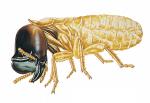Pest Identification
You're visiting our pest identification library with information about the biology and control of common household pests.
Subterranean Termite
| Appearance |
|---|
 While all termites have long narrow bodies, they vary greatly in appearance depending on the termite's role in the colony. Subterranean termite workers are pale cream-colored and 1/8-inch long; soldiers have elongated heads with pincer-like mandibles; and primary reproductives (commonly called "swarmers" and the termites most often seen in the open) are dark brown or black and 1 inch long, with large whitish wings. While all termites have long narrow bodies, they vary greatly in appearance depending on the termite's role in the colony. Subterranean termite workers are pale cream-colored and 1/8-inch long; soldiers have elongated heads with pincer-like mandibles; and primary reproductives (commonly called "swarmers" and the termites most often seen in the open) are dark brown or black and 1 inch long, with large whitish wings. |
| Habitat |
| Subterranean termites live underground and build protective mud tunnels above ground to search for food. They will die if exposed to open air for prolonged periods. Attracted to moisture (downspouts, leaky hoses, etc.), they will enter a building anywhere there is direct soil to structure contact. Colonies contain up to 2 million members, organized into castes depending on tasks- workers, soldiers and reproductives. Subterranean termites swarm in the spring, when groups of reproductive termites go off to start new colonies. |
| Diet |
| Like other termite species, they feed on products containing cellulose. Unlike other wood-destroying insects, termites actually eat the wood. |
| Control |
| Subterranean termites are by far the most destructive species. They can collapse a building entirely, causing financial ruin for the owner. To help prevent termite infestations, eliminate wood contact with soil. Make sure at least four inches of foundation can be seen all around the home. Avoid water accumulation near your home's foundation. Divert water away with properly functioning gutters, downspouts and splash blocks. Fix all roof and plumbing leaks as soon as possible. Options for controlling existing infestations include placing liquid pesticides in the soil around your home, or above-ground bait stations. |
Pest Library - Termites / Wood Destroying Insects Schedule a free inspection today






